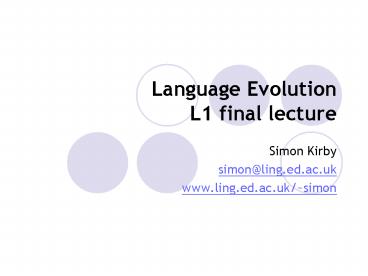Language Evolution L1 final lecture - PowerPoint PPT Presentation
1 / 19
Title:
Language Evolution L1 final lecture
Description:
... information in a sentence of human language. How the waggle-dance ... Using the human genome project to find 'language genes' What happened after 150,000 BP? ... – PowerPoint PPT presentation
Number of Views:59
Avg rating:3.0/5.0
Title: Language Evolution L1 final lecture
1
Language EvolutionL1 final lecture
- Simon Kirby
- simon_at_ling.ed.ac.uk
- www.ling.ed.ac.uk/simon
2
Banned in 1866!
La Société nadmet aucune communication
concernant, soit lorigine du langage, soit la
création dune langue universelle.
The Society will accept no communication dealing
with either the origin of language or the
creation of a universal language.
3
Lecture outline
Is language really unique to humans?
When did humans emerge?
What happened to give us language?
Some controversies
4
Animal Communication
- What is communication?
- One possible definition (E.O. Wilson)
- Do animals communicate?
- Yes, lots! (and plants too)
- So whats special about us? Reference?
Complexity? Acquisition?
Communication occurs when the action of or cue
given by one organism is perceived by and thus
alters the behaviour in another organism in a
fashion adaptive to either one of both
5
Vervet Language?
- Vervet monkey gives different alarm call for
three predators - Eagles
- Snakes
- Leopards
- Are these referential?
- Closed system mostly innate.
6
Bee Language?
- Honey Bees communicate about
- What direction to look for nectar
- How far away it is
- How good it is
- Easily as complex as information in a sentence of
human language
7
How the waggle-dance works
- Impressively complex, but innate and limited
8
Songbird Language?
Ring Ouzel
- Song in some species is learned
- Regional dialects
- Not really saying much
9
Kanzis Language?
- Saw language used from 6 months (critical
period?) - Able to understand some syntax
- Go get the carrot thats in the oven
- Put jelly in milk
- Put milk in jelly
10
Human Language
- Digital infinity/recursion
- Allows us unbounded expression we can talk
about anything
This is the farmer sowing the corn, that kept the
cock that crowed in the morn, that waked the
priest all shaven and shorn, that married the man
all tattered and torn, that kissed the maiden all
forlorn, that milked the cow with the crumpled
horn, that tossed the dog, that worried the cat,
that killed the rat, that ate the malt, that lay
in the house that Jack built.
11
When did humans emerge?
Last common ancestor with chimpanzee
6,000,000
4,000,000
Australopithecus
Homo habilis
2,000,000
Homo erectus
Homo sapiens
200,000
12
What happened leading up to 150,000 BP?
Changes in anatomy
Changes in mental capacities
Changes in social organisation
13
Anatomy 1 Bipedalism
- We stood up
- Frees up the hands (could gesture be the first
form of language?) - Breath control
- Change in shape of pelvis
- Conflict between big brains and birth canal
- Neoteny we are embryonic after birth
14
Anatomy 2 The vocal tract
- Vowels a, i, u only possible in homo
sapiens - Dangerous skill we can choke!
15
Joint attention and mind reading
- Q When children hear a new word, what do they
do? - A They look to see what the speaker is looking
at. - Difference in contrast between sclera and pupil
- Disadvantage chimps can hide what they are
looking at but we cant
16
Social Organization
- Group size related to size of brain
- Human group size 150
- Grooming holds together groups
- How can we groom? Use gossip!
17
Controversies
- What is the human biological capacity for
language? - An innate Language Acquisition Device
- LAD like an organ
- Did it evolve like the eye?
- It is adaptive, and complex
- Must evolve by natural selection
Language Acquisition Device
Utterances
Grammar
18
Gradual or Big Bang?
- Could LAD evolve gradually, or as one improbable
mutation? - We need fossils of early protolanguage
- Living fossils
- Early child language
- Pidgin languages
- Trained chimps
- PROTOLANGUAGE
- No closed-class words
- No grammatical endings/morphology
- No embedding, relative clauses etc.
- No established word-order
19
The future
- Two new approaches
- Using computers to simulate how language can
evolve - Using the human genome project to find language
genes
- What happened after 150,000 BP?
- Cultural transmission
- Language evolution on a cultural timescale?






























